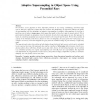Free Online Productivity Tools
i2Speak
i2Symbol
i2OCR
iTex2Img
iWeb2Print
iWeb2Shot
i2Type
iPdf2Split
iPdf2Merge
i2Bopomofo
i2Arabic
i2Style
i2Image
i2PDF
iLatex2Rtf
Sci2ools
CGF
1998
1998
Adaptive Supersampling in Object Space Using Pyramidal Rays
We introduce a new approach to three important problems in ray tracing: antialiasing, distributed light sources, and fuzzy reflections of lights and other surfaces. For antialiasing, our approach combines the quality of supersampling with the advantages of adaptive supersampling. In adaptive supersampling, the decision to partition a ray is taken in image-space, which means that small or thin objects may be missed entirely. This is particularly problematic in animation, where the intensity of such objects may appear to vary. Our approach is based on considering pyramidal rays (pyrays) formed by the viewpoint and the pixel. We test the proximity of a pyray to the boundary of an object, and if it is close (or marginal), the pyray splits into 4 sub-pyrays; this continues recursively with each marginal sub-pyray until the estimated change in pixel intensity is sufficiently small. The same idea also solves the problem of soft shadows from distributed light sources, which can be calculated...
| Added | 21 Dec 2010 |
| Updated | 21 Dec 2010 |
| Type | Journal |
| Year | 1998 |
| Where | CGF |
| Authors | Jon D. Genetti, Dan Gordon, G. Williams |
Comments (0)

